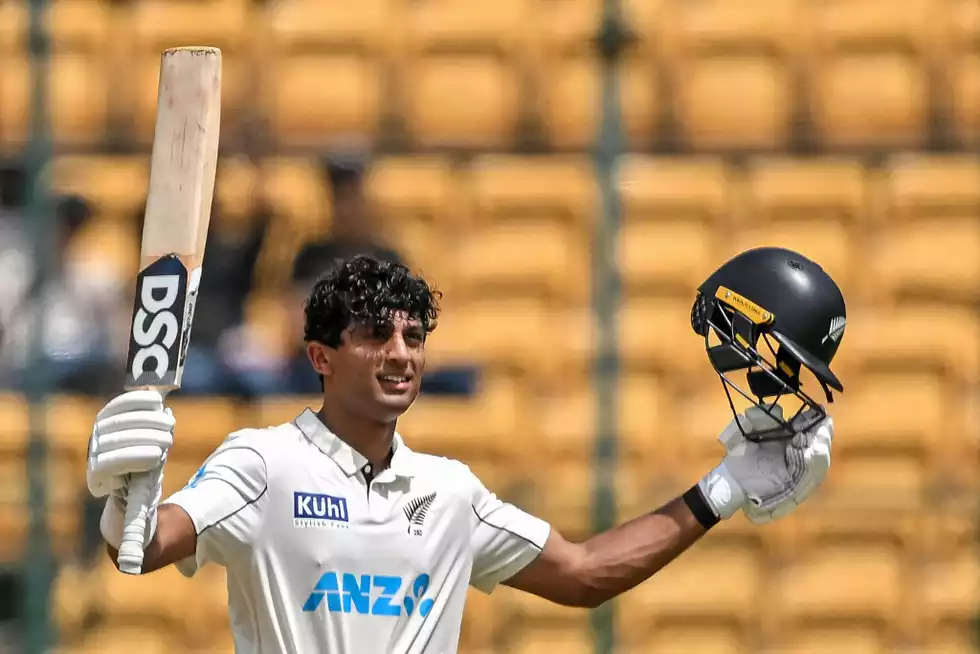On the third day of play in Bengaluru, a remarkable total of 453 runs was amassed, but it was India’s bowlers who initially seized control, claiming four wickets for just 40 runs and putting New Zealand under pressure. However, the spotlight soon shifted back to the batsmen, particularly Rachin Ravindra, who scored an impressive 134, supported by a spirited innings from Tim Southee. The bowlers from both sides faced a challenging day as conditions had drastically changed since the first day. Each batter approached their innings in their own unique style, but for Ravindra, his accustomed method of play shone through.
Ravindra’s scoring was predominantly through the onside, with an impressive 58% of his runs coming from that area. His ability to achieve this without relying on the traditional sweep shot—a common tactic for visiting batsmen facing Indian spinners—sets him apart. When he did opt for a sweep, it was the slog-sweep through midwicket that resulted in four sixes. The majority of his onside runs, totaling 67 out of 78, came from shots played in the midwicket and long-on regions.
The Bengaluru pitch remained favorable, although it occasionally kept low, presenting some difficulties against India’s spinners. However, the pressing challenge for New Zealand was to avoid letting India regain momentum. The partnership between Ravindra and Southee, which produced a rapid 137 runs off 131 balls, significantly shifted the balance back in New Zealand’s favor.
“On a pitch like this, you can afford to be selective,” Ravindra stated after the day’s play. “It wasn’t offering too much movement—there weren’t any significant challenges. In modern Test cricket, there’s an expectation to be proactive and keep the scoreboard ticking, especially with the way teams are scoring runs globally. For us, the goal was to push forward and capitalize on the opportunities available.”
With New Zealand at seven wickets down, Ravindra acknowledged the need to maintain pressure and build on their lead. “It was still a decent wicket to bat on, and we needed to keep scoring. The chances to score were there, and we took them,” he noted.

As the innings progressed, Ravindra reintegrated the slog-sweep into his game, a shot he had previously put aside, though one eventually led to his dismissal. His methods against spin impressed not just the crowd but also the Indian players, who recognized his skill as he walked off the field at the end of the day.
Kuldeep Yadav, who had almost dismissed Ravindra on a couple of occasions, complimented his performance. “He batted exceptionally well. I missed a couple of opportunities to get him out. He has developed significantly over the last two years, showcasing a solid batting technique and looking quite comfortable against spin.”
With a playful grin, Kuldeep added, “I just hope he doesn’t continue to bat like that in the upcoming matches against us.”
Ravindra sharpened his skills against spin at the Chennai Super Kings academy before the Tests in the subcontinent, training on various types of wickets. “It was an invaluable experience. Given our success leading up to this point, I thought it would be beneficial to spend a few days training there. The conditions were much more realistic compared to the used or doctored wickets back home in New Zealand,” he explained.
Also Read:New Zealand Clinches Thrilling Victory to Secure Spot in T20 World Cup Final
“The CSK team was incredibly helpful, providing me with four or five days of focused training on red and black soil pitches. This preparation was essential in helping me develop strategies and refine specific aspects of my game,” Ravindra elaborated.
His deep-rooted connection to Bengaluru, where his family originates and where he previously achieved a World Cup century, has now gained another chapter with this stellar performance. As the focus remains on batting, India’s bowling contingent will likely have Ravindra in their sights with much of the series still to unfold.
